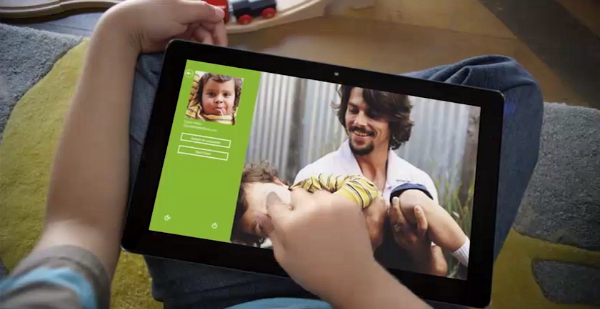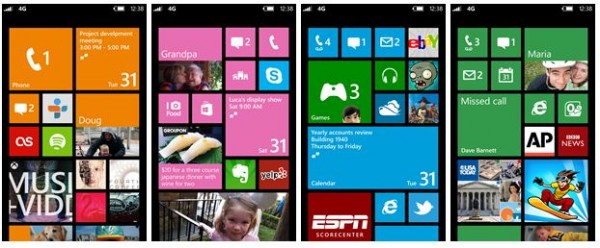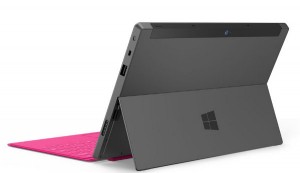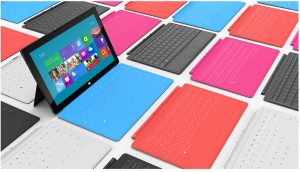Microsoft's road to redemption

Microsoft just put behind it an eventful and positive week, coming off two major announcements on its two major computing platforms -- Windows and Windows Phone: Surface and WP8. Consumer and expert scepticism hobbled much of the excitement, as Microsoft nose dives into paradigm change. Nevertheless, the third week of June 2012 is indicative of a profoundly new direction for Microsoft, characterized by refreshing perspectives and paves a path that leads ultimately in the right direction.
Microsoft is making genuine inroads towards a new strategy that represents a complete paradigm shift from the fundamentals that defined the company and its products over the last couple of decades. The company used to be the antithesis of Apple in practically every sense, selling products based on the abundance of choice as opposed to Apple's strategy of marketing a small hardware lineup. Apple's strategy has always focused on ease of use, simplicity and form; whereas Microsoft, although not neglecting form and aesthetic, put functionality first and foremost and wrapped design around this in the most appealing way possible. The announcements this week represent a fully-committed digression from this strategy from Microsoft.
Although success or fruition is yet to be realized, it's a positive sign that Microsoft has noticed the writing on the wall and has taken action; and not action in a languid or half-assed manner.
Basic Unravelling as Microsoft Stumbles
There's no denying that Microsoft has remained relatively stagnant over the past 5 years, promising products and ideas that by the time of fruition were far too little too late. Competitors in Apple and Google have taken strides to pull the rug from Microsoft's feet and dominate an app-driven smartphone market vastly different from the other type of smartphone that used to be the joint of two big monsters -- Windows Mobile and Research in Motion's Blackberry.
Apple's iPhone took the industry by surprise -- coincidentally 5 years ago this week -- sparking the entire market into a flurry, forcing the conception of noticeably unpolished and hurried products, many running Android with fear of being far too little too late. Creative, inspired and refreshing approaches at penetrating the tablet market by the likes of Fusion Garage and HP's webOS were met with closed wallets resulting in the sad and complicated demise of the former and the hasty and comically brutal termination of the latter.
All the while Microsoft seemingly sat steadfast on its burdens of power, market share and cash, taking its time with its planned smartphone reboot and giving no indication of an imminent entrance into the Apple-ruled tablet market. Its competitors continued to make strides.
Microsoft's story so far is perhaps a cautionary tale that in an industry that is driven predominantly by progressions in software and ecosystems particularly, things move fast. The concept of the 'app store' which was brought to the limelight by Apple's aptly named 'App Store' is the perfect manifestation of the ecosystem's equally constructive and destructive powers.
The ecosystem in consumer technology is defined best as products and services that are built for each other and are designed to work best together. The aim of the ecosystem is that the end consumer will get the most out of their products and services if they choose products and services bred in the same ecosystem; and it is to the user's expense to have to diffuse their personal technology portfolio across multiple. To illustrate this point, it’s fairly obvious that a consumer would be increasingly more productive and enjoy a greater user experience in using in tandem an iPad, iPhone and a MacBook Pro as opposed to an Android smartphone, Blackberry Playbook and a Windows PC combination.

To get back to the original point, a growing ecosystem has phenomenal constructive powers for obvious reasons. It acts as a hive for passionate developers to voice and distribute their creativity, it allows vast amounts of content to be distributed and it allows the users first and foremost to be productive and enjoy a great user experience. The most threatening thing about growing ecosystems from the industry's vantage point though is that they grow geometrically -- accelerating faster and faster as they grow more and more. Large user bases attract developers, apps from developers attract users and the process continues, becoming more prevalent as it progresses.
This brings to light the destructive side of ecosystems; their growth is initially unremarkable, but the geometric quality of their growth catches competitors out when they're not nimble on their feet, as is the case with Microsoft. Completely blindsided, Microsoft found itself in a situation where its mobile OS looked light years out of date and its ferocious attempts at playing catch up were a time suck. Fast forward to 2012 and Microsoft is playing as the hopeful startup in industries it used to dominate.
Of course, competitor factors are not the sole reason for Microsoft's tragic and inexorable fall from grace. The company ultimately was far too narrow-minded forcing the top brass to miss filling in crucial gaps such as integrating their vast library of devices and software. Commanding ease of use was clearly an aspect of user experience with avenues to explore and vast potential to improve; however, Microsoft made no ground-breaking alterations sticking with its -- by today's standards extremely cumbersome -- Windows Mobile operating system. And, of course, traditional Windows tablets formed a foundation that Microsoft didn't quite have the smarts to unlatch. Apple got there first, despite Microsoft's eight-year market lead.
On Windows Phone
Microsoft launched Windows Phone 7 in late 2010 engulfed by an aura of excitement and anticipation. Despite this, Windows Phone has thus far failed to be the stopgap that Microsoft has needed -- dragging its heels in smartphone market share and despite being no slouch, its app store still lags behind established players in Google and Apple. Windows Phone launched as a half-done operating system, which diminished a lot of excitement and hype that could have accumulated and translated into sales. The lack of basic functionality at launch -- basics like cut and paste -- and any semblance of a useful multitasking arrangement gave it the essence of a prerelease beta that just happened to run really well and be astonishingly low on bugs.
I was one of those who fell head over heels with Microsoft's Metro design language and became an early pre-Mango adopter of Windows Phone. Coming straight off a Sony Ericsson feature (dumb) phone I didn't expect to be jolted by its lacking app store at the time, and I wasn't. Though of course, I have stumbled across several desirable Android and iOS apps not available on Microsoft's emerging platform. Either way, Windows Phone 7 -- with strong regard to its stellar user interface and experience -- was a promising start to an array of fundamentals that are defining the new Microsoft as it approaches this technological era of immediacy and simplicity.

Last week's Windows Phone 8 reveal is ground-breaking for a number of reasons, the most prevalent being of course -- as many respected tech bloggers have pointed out -- is that it has crossed out one by one many of the platform's limitations and has almost levelled the platform with iOS and Android; even surpassing them on some levels. More importantly, Microsoft has managed to add this much-needed level of functionality, detail and refinement without detracting from the operating system's most apparent selling point -- the stunning UI.
Sure, in the endless spec war Microsoft's OS is nothing spectacular against many Androids on the market. Windows Phone 8's resolution support maxes out at WXGA (1280 X 768), which is plenty but with the iPhone's renowned Retina display already standing at a commanding 960 X 640, we can only expect smartphone display resolutions to grow. Windows Phone 8 also supports multi-core processors, which is an instrumental addition given Windows Phone 7's support of a limited single-core Snapdragon processor, which was already relatively aged at the time of its utility. However, Androids have had this capability for years. On the hardware front, Windows Phone 8 only just levels Microsoft with its competitors, but that's good enough.
Despite the obvious shortcomings, Microsoft has with its new mobile and computing strategy, trajectory that looks far more solidified than that of Google and exhibits much promise. Microsoft's Nokia partnership is crucial to the future of the mobile platform. Nokia, in having no choice but to build hardware for Microsoft's platform has every reason to throw all its eggs, and the very best eggs into the Microsoft basket. We've seen the epitome of Nokia's hardware prowess in the engineering feats and aesthetic milestones that are the Nokia Lumia 800 and 900 smartphones, and we can expect Windows Phone to continue to be treated to the very best of Nokia's design and engineering.
Experience, Feelings and Emotions
The Surface announcement acts as a solidifier for Microsoft's clear change in perspective.
Although we know Microsoft primarily as a software developer, it's increasingly evident that the company is beginning to see the genuine value behind great hardware integration, too. Apple hasn't labored to hide the fact that its products are incredible because of the unmoving marriage between hardware and software. Microsoft knows that the old strategy of allowing OEMs tremendous freedom enabled a certain celibacy between its software and the hardware of OEMs. Strict hardware guidelines enforced on Windows Phone devices ensure uniformity in user experience and performance, a level of non-fragmented consistency that Android could only dream of. There are significant grounds to predict that Microsoft will also elect to enforce guidelines on OEMs of Windows 8 tablets and PCs.
Nokia's close partnership with Microsoft opens potential for strong marriage between hardware and software. Great user experiences can only occur at their very best when hardware and software are designed specifically to work together.
 Microsoft’s Surface has been received with excitement, though perhaps not the optimism from pundits that the company would have liked or expected. Personally, I expected much more excitement about Surface and see it as the way tablets should have been done right from the very start. The Los Angeles unveiling was much more than a simple product announcement; it was a proud and public display of a changed Microsoft that has adapted to the changing dynamics in the computer industry. Suddenly, user experience and the consumer’s feelings associated with a product are paramount, whereas much more quantifiable aspects such as features, specs and price have fallen to second priority.
Microsoft’s Surface has been received with excitement, though perhaps not the optimism from pundits that the company would have liked or expected. Personally, I expected much more excitement about Surface and see it as the way tablets should have been done right from the very start. The Los Angeles unveiling was much more than a simple product announcement; it was a proud and public display of a changed Microsoft that has adapted to the changing dynamics in the computer industry. Suddenly, user experience and the consumer’s feelings associated with a product are paramount, whereas much more quantifiable aspects such as features, specs and price have fallen to second priority.
Buzzwords such as "feeling", "confidence" and other emotionally correlated keywords were rampant during Microsoft’s announcement, whereas the classic table of specifications and price lists were noticeably absent. Microsoft didn’t even make the effort to say the product would be price competitive, nor aim to build something modelled on price competitiveness or a competitive spec sheet. Sentiment and experience are the keys to Microsoft Surface and clearly played a large hand in the product’s development.
Panos Panay, the general manager of Surface took the stage and engulfed us in a showing more reminiscent of an Apple event speech more than any other. Something as trivial as the product’s kickstand had been subject to gold class treatment from the engineering team and Panay was not afraid to boast, informing us of the "visceral feeling and emotional attachment [you have] to your product when you open this kickstand and close it".
 In reference to the tactile feedback of the device’s discreetly engineered kickstand Panay asserted that "it feels great". Heck, Microsoft even took advantage of an anechoic chamber to engineer the sonic tactility of the kickstand’s opening and closing. When talking about the aligning magnets engineered into Surface’s attachable keyboard he ensured the audience that it was designed in such a manner that it’s virtually impossible to miss when attaching the keyboard. He then specified that they "do that to give you confidence".
In reference to the tactile feedback of the device’s discreetly engineered kickstand Panay asserted that "it feels great". Heck, Microsoft even took advantage of an anechoic chamber to engineer the sonic tactility of the kickstand’s opening and closing. When talking about the aligning magnets engineered into Surface’s attachable keyboard he ensured the audience that it was designed in such a manner that it’s virtually impossible to miss when attaching the keyboard. He then specified that they "do that to give you confidence".
This obsessive attention to detail on aspects of the product that are initially trivial is indicative of this new approach by Microsoft in viewing the user experience on all fronts as preeminent to the product’s success. The importance of the emotional targeting of products is perhaps best illustrated by a TED talk given by Simon Sinek: "How Great Leaders Inspire Action". This TED talk was popularized in the tech industry when it was referred to in an open letter to RIM’s senior management, which was a plea for them to model their actions in line with Sinek’s theories. Although the issue of leadership seems irrelevant, many aspects of Sinek’s ideas are pertinent to product marketing and development and by extension to Microsoft.
Sinek’s theory is based on biology and psychology and the separation of the brain into two main parts -- the neocortex and the limbic. The neocortex is responsible for rational decision-making and facts and figures, whereas the limbic brain is responsible for emotions and irrational gut decisions. Thus, by targeting consumer’s rationality through price and specs it’s easy to communicate a product's merits and features; however, sometimes it just "doesn’t feel right". However by targeting products directly at the limbic brain through unquantifiable qualities such as user experience, it’s much easier to instigate purchases and positive consumer sentiments.
So obviously, the way consumers feel about a product is crucial, and by appealing more to the subtle emotions consumers invariably associate with devices instead of solely relying on more rationally considered aspects such as specifications, Microsoft ensures its consumers develop strong positive emotional attachments to its products and also immense customer loyalty. Both of these aspects have been tremendous stepping stones in Apple’s success and it’s a positive sign for Microsoft that they’re taking the appropriate steps to emulate that.
Uniformity
Integration in the new ecosystem approach is the essential element, the one that binds the ecosystem and ensures an ordered and functioning society if you like. Integration is also something Microsoft has lacked recently, particularly when stacked against Apple -- the unarguable doyen in this category.
Microsoft’s current lineup is a disjointed family. Windows and Xbox rarely communicate, and Windows Phone could be assisted from being a hell of a lot closer to all of it too. The truth is that many of Microsoft’s products are successful standalones; Windows market share in the PC industry is enormous, however, this success wouldn’t be correlated closely with the success of the Xbox or vice versa. It’s possible that Microsoft’s offerings in these two separate markets could have been even more successful if there was a larger degree of convergence between them, meaning that when utilized in tandem they would complement each other.
Windows Phone has been fundamentally left out of the equation, with convergence with Microsoft’s portfolio of software and services only going skin-deep. Xbox Live on Windows Phone is merely a shallow use of Microsoft’s big brand in gaming but without any genuinely useful integration aside from the ability to gain achievement points on mobile Xbox Live games. The vast majority of Windows Phone’s Microsoft-exclusive software is simply branded versions of generics, notably Internet Explorer and Microsoft Office.
But all this has changed with the introduction of Windows 8 and Windows Phone 8. For the long-run, the most significant advancement from WP7 to WP8 is the shared kernel with Microsoft’s Windows 8 tablet and PC operating system. Microsoft dubs this the "Shared Windows Core"; without delving into technical bombast the primary advantage of this is going to be the easy porting of apps cross-platform. From a developer standpoint this is advantageous because developers will only have to fully write an app once for it to be able to jump from a Windows Phone, to a Windows Tablet and to a Windows PC.
From Microsoft’s standpoint, this is advantageous because it will enable a swift proliferation of high-powered and fully-functional apps in Windows Phone’s marketplace. A lagging app store has perhaps been the largest reason behind the slow adoption rate for Windows Phones, and this will do no harm in fixing that. Microsoft’s PC empire is not going to slow down because of Windows 8; in fact, it will fasten due to its head-on entrance into a tablet market with significantly lower price barriers than the traditional desktop market.
Microsoft’s Windows operating system is now more accessible to more potential consumers which will result in an inevitable rise in user base. The geometric growth theory of ecosystems will once again take place as developers flock to the platform with a large audience. Microsoft has been clever in leveraging its desktop stronghold in order to boost its emerging mobile platform -- a path you could say they should have taken from the very start.

But the Marketplace growth is not the sole benefit of this announcement; the shared core between Windows 8 and Windows Phone 8 also works towards an even greater goal of uniformity and cohesion across Microsoft’s ecosystem -- a heavenly state which the company has promised for three years since Microsoft’s former chief software architect, Ray Ozzie declared the phrase "three screens and a cloud" back in early 2009. The three-screens approach encompasses personal computers, phones and televisions as our primary mediums of technology consumption and how networking and integration would ensure the blessed amalgamation between the three.
Of course, television hasn’t been left out of the equation and Microsoft’s E3 presentation hinged on further and deeper integration among its portfolio of products and services. Xbox’s user interface has inherited traits from Microsoft’s Metro design language, which is the pretty face of Windows and Windows Phone. The Zune brand is being recycled as it transforms into Xbox Music, clearly a streamlining effort as Microsoft cleans itself of low-value brands and instead focuses on a smaller and more centralized service offering. This rebranding is indicative once again of the "Apple-isation" of Microsoft if you like, in the sense that the company condenses its portfolio into a smaller lineup with significantly higher value.
Xbox Smartglass, the biggest and most publicized fruit of Microsoft’s E3 event further reinforces addressing cohesion and integration -- enabling Windows Phones, Windows PCs and tablets to engage and communicate with the Xbox hardware, software and brand in a manner that is far more than skin deep. Not to mention, the Xbox Smartglass project could represent in itself a revolution in the gaming industry, opening up new avenues for engaging with games and entertainment content. Though, we’ll wait and see what developers are able to come up with in working with the Smartglass SDK.
Microsoft understands the importance of the living room, and it’s of particular pertinence given it’s the only factor of the ecosystem equation not yet dominated by solidified players. Sony is struggling to excite, the Apple TV isn’t a characteristic breakthrough by Apple, and Google is yet to gain its footing. The Xbox 360 is Microsoft’s big chance, and it has the chops to deliver -- in a manner that too manages to complement and ameliorate the remainder of its ecosystem. It’s time to deliver.
The Road Ahead
This article should not be misinterpreted as a guarantee for future success, nor is it a fanboy preach. Like MG Siegler once wrote in response to being labelled "a professional Apple fanboy": "I’m a fanboy of good products. And I always will be". I’m the exact same way, and personally I think that Microsoft makes great products, hence why I’m shameless in supporting it. Though, of course, this is not blind support, and I didn’t write this optimistic article to put Microsoft on a pedestal and to force myself and you to believe that it will be successful.
I’ve used Windows Phone long enough to form a reasonably objective stance (contradictory, I know) on it -- it’s a good product. And basing Windows Phone 8 on the merits of Microsoft’s presentation there’s no reason to believe that it’s not going to get better. I’ve only used Windows 8 sparingly, so I’m not in a position to say whether it’s good or bad; however, I am in a position to bet that Microsoft’s trajectory is most certainly the right one.
Microsoft’s pursuit of its networked three-screened ecosystem is finally beginning to take shape and bear tasty fruits. The company’s renewed focus on user experience and refined details is a refreshing and positive change of pace. The technical leaps obtained in Windows Phone 8 are a godsend to the emerging platform. Microsoft Surface is a promising look into the future and if the convergence effort with Xbox Smartglass is here to prove anything, it’s that Microsoft does indeed know what it’s doing. This all paints a rosy picture for the influential tech giant, a strong suggestion that the path Microsoft has paved for itself -- no matter how rocky -- is unmistakeably the right one.
Photo Credit: Dudarev Mikhail/Shutterstock
